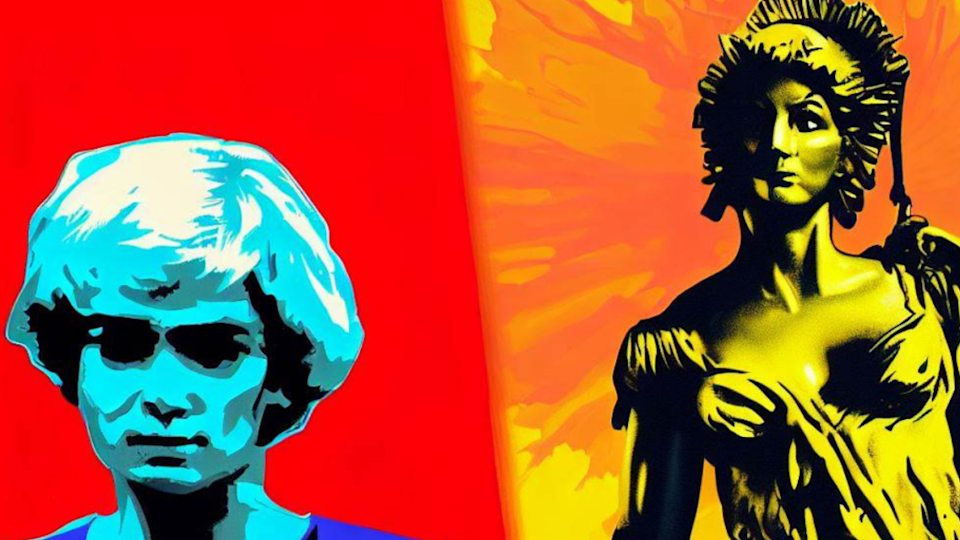Big AI Implications Lurk in the Supreme Court’s Andy Warhol Verdict | Analysis
- Oops!Something went wrong.Please try again later.
In a move that could complicate the legal status of AI systems trained on existing visual artworks, the Supreme Court of the United States ruled Thursday that Andy Warhol’s 1984 work “Orange Prince” infringed on the rights of rock photographer Lynn Goldsmith because the work’s commercial intent was not covered by the “fair use” exemptions in copyright law.
It’s hard to argue with the commercial ambitions of AI-powered art, given that companies behind the trend, like Stability AI, are seeking valuations measured in the billions of dollars. Legal questions surrounding the field are already mountainous in volume and scope. The new ruling appears sure to muddy matters.
AI art is art “created” by artificial intelligence, which achieves the task by analyzing images it has access to — sometimes called “scraping.” Typical data sets include a large portion of the visual internet. Most artists have not consented to AI tools learning from and reinterpreting their art, especially not for commercial purposes.
Also Read:
AI and the Law: It’s the ‘Wild, Wild West’ Out There
The AI art camp argues that the generated works are sufficiently transformative (since they are in effect amalgamations of many different works) so as to not be blatant theft. The Warhol ruling throws a new potential wrench into the works, arguing that transformative value alone is not enough to avoid copyright infringement when the potentially infringing work is commercial in nature.
The justices wrote in the ruling that “if an original work and secondary use share the same or highly similar purposes, and the secondary use is commercial, the first fair use factor is likely to weigh against fair use, absent some other justification for copying.”
Big implications for AI
“This decision is particularly interesting due to its likely implications for artificial intelligence,” said Copyright Alliance CEO Keith Kupferschmid. “Before the decision, some AI developers had relied on fair use to use copyrighted works without permission or compensation. This decision all but ensures that AI developers need to get permission from — and compensate — creators if they want to use their works to train their AI systems, and can no longer rely on fair use arguments that were specious even before this case was decided.”
The ruling doesn’t change copyright law, Kupferschmid argued: It simply clarifies the law and the definition of transformative use.
As a consequence, “I think that the creators will need to be careful about how derivative AI art is commercialized,” said intellectual property lawyer Bart Lazar of Seyfarth Shaw LLP.
Also Read:
Supreme Court Rules Andy Warhol’s Prince Images Violated Photographer’s Copyright
Lazar pointed out that a key factor in the Supreme Court’s decision was that “the Warhol work was licensed as a replacement for the Goldsmith photo.” The fact that Warhol’s image was used by Vanity Fair as an illustration in an article weighed heavily on the decision.
But the legal world is far from a consensus on the broader impact of the ruling. William Scott Goldman, managing attorney at Goldman Law Group, wasn’t certain the court’s verdict would have major consequences for legal interpretations of fair use.

“The court appears to be merely offering its own narrow interpretation of how a transformative work is to be defined, within the confines of this particular case only,” said Goldman. “As such, copyright owners may feel encouraged to rely on today’s decision when bringing future actions, but it might not have much measurable effect beyond setting a basic threshold on the question of what could potentially qualify as transformative under a fair use defense.”
In other words, the debate remains unsettled and the Warhol ruling by itself won’t pull AI out of the copyright quagmire.
Cheers from the media world
Nevertheless, large trade groups heavily invested in protecting their members’ copyrights lauded the decision.
“Lower courts have misconstrued fair use for too long and we are grateful the Supreme Court has reaffirmed the core purposes of copyright,” Recording Industry Association of America CEO Mitch Glazier wrote in a statement. “We hope those who have relied on distorted — and now discredited — claims of ‘transformative use,’ such as those who use copyrighted works to train artificial intelligence systems without authorization, will revisit their practices in light of this important ruling.”
The Motion Picture Association also applauded the Supreme Court’s verdict, saying it reaffirmed “the importance of copyright to the motion picture and television industry and other creative endeavors.”
More cases will likely emerge to clarify issues around training AI on human artists’ works. Stability AI, Midjourney and DeviantArt are facing a lawsuit by a group of artists alleging infringement, for example. Such cases will take years to wind their ways through the courts before they could even potentially land before the Supreme Court. Consider the Warhol case the first word, far from the last, by the law about this currently unchecked legal frontier.
Also Read:
The Hollywood Writers’ Strike May Actually Be Aiding AI’s Takeover

